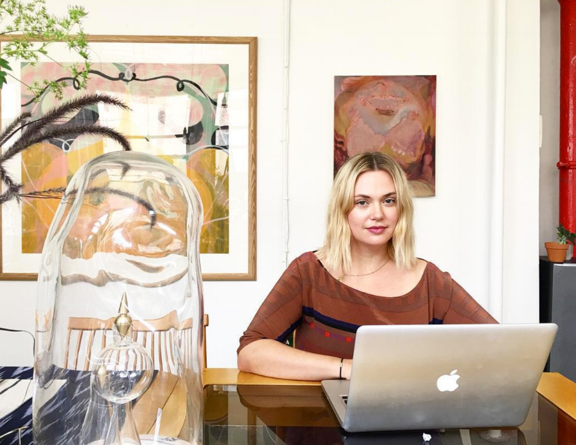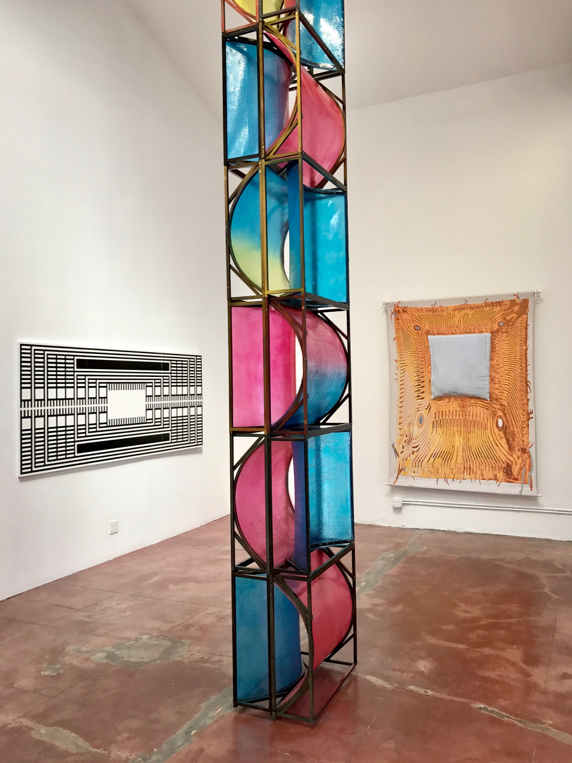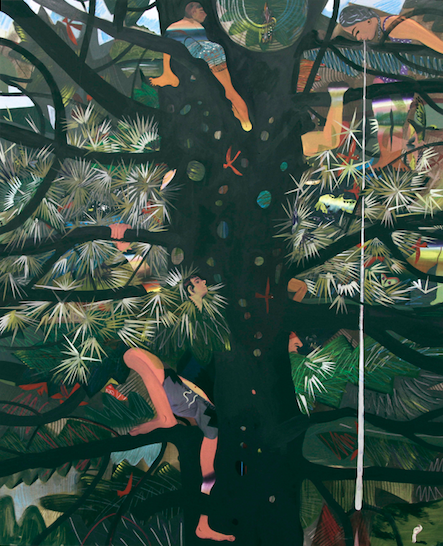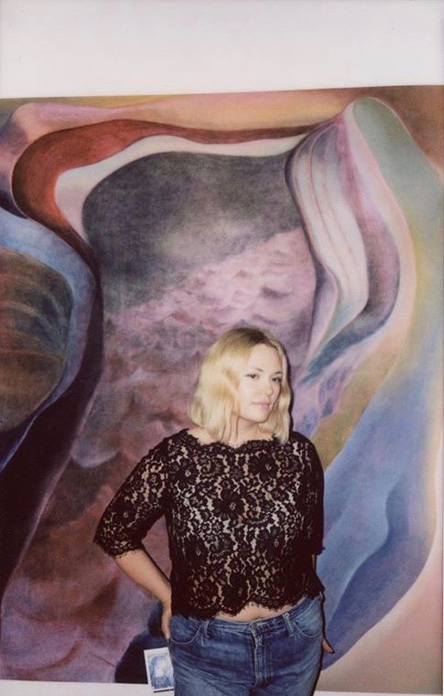People
artnet Asks: HILDE Gallery Owner Hilde Lynn Helphenstein on the Women-Run West Coast Art Scene
…and that one time her gallery became a cult chapel.

…and that one time her gallery became a cult chapel.

Artnet Galleries Team

Her background as a trained artist and academic is where the traditional ends for HILDE gallery owner Hilde Lynn Helphenstein. In September 2017, 11 months after the opening of HILDE in Los Angeles, Helphenstein unveiled HILDE e.b., a second project space in Oakland. In her spaces, she seeks to spotlight philosophical, poetic quandaries, and provide artists with a platform for “fighting the darker aspects of contemporary culture.” From combating misogyny in the art world to welcoming artists into her home with complete freedom to create, there is an adventurous, unbounded quality evident in her endeavors.
Helphenstein sat down with artnet News to tell us about the inaugural exhibit at HILDE e.b., the art she’d love to own, and how one might go about creating a “god light.”
What prompted your decision to open a gallery in Los Angeles?
It was a complete fluke that I opened in Los Angeles. I initially came to LA to work on an Andy Warhol/Richard Pettibone exhibition for Water McBeer and I never left.
I find LA to be an ideal blend of the other places I’ve lived. LA is fast and sharp like NYC, minus some of the traditional politics. You can be “wild” without having to explain yourself. The light also happens to be exceptional and there’s so much more space.
After training formally as an artist for six years, I dove head-on into the business element of art. I became obsessed with what Andy Warhol coined, “art as business/business as art.” My approach to all of this has been holistic and naive, and it’s suited me to learn the business this way. My work experience in galleries has ranged from artist-run to blue chip.
A year and a half ago I knew it was time to change direction. My vision began to crystallize, it was time to open HILDE.
You just opened a second project space in Oakland. What attracted you to the Bay Area?
This is a long story, but in short, be careful what you say when you’re drinking negronis (plural).
Tell us about your background in art and what led you here.
Traveling the world and meeting so many artists, from every walk of life, has dramatically changed how I feel about contemporary art.
I have a traditional academic art background, but I also studied at an anarchist art school in Norway for two years. I’ve lived in some extreme places like Siberia and the countryside of Catalonia and spent significant periods of time in London, Miami, New York, Gothenburg, San Francisco, Copenhagen, and Istanbul. I also studied literature for two years and a spent a year producing films.

“Drone of Perseus” (2017) installation view. Left: Mark Sengbusch, Radio Stall. Center: Thomas Liner, Cascading Wave. Right: Robin Kang, Golden Shield. Courtesy of HILDE.
What are the current exhibitions at HILDE?
Our recent exhibition was “The Drone of Perseus” in LA and currently “Somewhere I Have Never Traveled” is in the East Bay. “The Drone of Perseus” is about non-alphanumeric communication with future generations. For this, I enlisted more abstract artists who work with concepts surrounding color, light, sound, and geometry. There’s an epic 21-foot Thomas Linder sculpture called Cascading Wave hanging from our skylight and hovering just an inch above the ground. The show features jacquard weavings of computer memory processing chips from the USSR by Robin Kang, brutalist abstract paintings by Linnea Rygaard, and Mark Sengbusch’s scrimshawed wooden panels.
“Somewhere I Have Never Traveled (A Study in Transformative Processes)” is a solo presentation of Robert Canali’s work. The title of which comes from an E. E. Cummings poem. 11 years in the making, Canali’s free-form travelogue catalogs the last days of the San Francisco Flower Mart, while simultaneously exhausting his stock of analog photographic materials. These parallel journeys are illustrated by large-scale, painterly exposures. A total of 252 sheets of dead stock photo paper and discarded flowers make up the six completed compositions in the exhibition.
The moment the flowers hit the light-sensitive paper, they became emblematic of transformative processes, a memory of a memory. This is important considering where HILDE e.b. is located. We are currently set up in the former Claridge Women’s Hotel’s ballroom. The Art Deco architecture with hand-carved molding is stunning. The hotel was originally designed for the working class women of the Bay Area of the 1920s through the 1950s. It is still a functioning SRO (single residency occupancy) hotel. Both the exhibition and the space share a unique history.
How do you select the artists you choose to exhibit? How much does your personal taste play a role in your selection?
I use my exhibitions to take on larger existential, esoteric, and philosophical quandaries. Poetry has also positioned itself strongly in all of the shows. For example, we did an exhibition called “The Edge of Doom” which was culled from the Shakespearean Sonnet 116. I was obsessed with love that just makes you sick and pushes you out on a ledge naked. I started thinking about Rainer Werner Fassbinder’s Veronika Voss and Caravaggio’s Bacchus, then artists started coming to mind.
Louis Fratino painted Frog Hollow, which is about a doomed summer love and all of its delights. The large composition depicts a group of friends and lovers hanging from the limbs of a large tree. The joy is palpable, as is the anxiety of bodies perched from such great heights. For this exhibition, we also worked with the artist/poet Nicole Reber, my idol George Kuchar, Kristy Luck, Nick Farhi, Melanie Moczarski, Heidi Hahn, and Sam Spano. There were bestiality paintings, psychedelic dreamscapes, and paintings of nude women in dog masks. The exhibition was structured like a film, specifically an obsessive love story. The show tells a story set slightly beyond the apex of ripened love on its journey to wilted roses, fermented grapes, and wrinkled cheeks.

Louis Fratino, Frog Hollow (2017). Courtesy of HILDE.
The summer exhibition “HYDROGENESIS” came about in a similar way. I’ve been working with and showing Ohlsson/Dit-Cilinn for a few years now. Initially, I invited them to come live in LA, live in my bedroom, and start a cult in the gallery. I set them free to do anything they wanted. They came up with something way wilder than I could have imagined. They essentially started an oceanic Heavy Metal religion and turned the gallery into a chapel for it. The body of a 1970 El Camino filled with sand and covered in seaweed was erected inside the gallery. They altered the architecture of our space to give the impression of riding on a spaceship a thousand years in the past. During an alternative viewing, only the “god light” (a crucifix-like pole projecting a high watt light through a yellow raincoat) lit the space filled with smoke, incense, and 100 lit candles. People lined the street like they were waiting to get into Berghain. I was the bouncer. Each visitor was instructed to be silent unless praying to Mother Tiamat, a primordial goddess. Ohlsson/Dit-Cilinn created a 44-minute soundscape replete with black metal, the sounds of the ocean, and drones. It sounds insane but people stayed for 88 minutes or more. When the lights came on, a few people were rolling around on the floor making out. I’d say it was a success, the religion was born!
What is the biggest challenge that you’ve faced since you opened HILDE?
I’m very lucky to have received support from the art communities in Los Angeles, San Francisco, New York, and Stockholm. I’ve had the privilege of working with some of my favorite artists. However, I have had my challenges.
Like any industry, I deal with some pretty entitled men on a regular basis. I’ve experienced men walking into the gallery looking for my boss, and some Harvey Weinstein-style misogynists. Last week I had a male collector confuse a business meeting for a romantic date. Within the span of a two-hour conversation, I had to verbalize that I wasn’t interested in discussing his virility or running away to Vegas with him. This dynamic undermines my education and all the hard work I’ve put into my gallery, my artists, and my career. I am disappointed that so many women are afraid to voice their experiences for fear of repercussions. I won’t deal with misogyny. There is no place for it in the art world, there’s no place for it anywhere.

Ohlsson/Dit-Cilinn, Hydrogenesis (2017). Courtesy of HILDE.
If you could own any artwork, what would it be and why?
I play this game with myself once a week. It would be dreamy to own a giant Hilma af Klint painting. I feel like she is my spiritual mother. Last year I bought a Kristy Luck painting and it is one of my most treasured possessions. I also have an amazing Esther Ruiz that brings me a lot of joy! I’m hoping there will be a Linnea Rygaard painting in my life sometime soon! I believe in surrounding myself with the objects these minds produce.
What has been your proudest moment?
This has been the biggest year of my life. The chance to create the world I want to see in real time has been the most beautiful experience thus far. I finally have the platform I’ve always dreamed of to provide talented and worthy artists with an opportunity to grow, investigate, and expand their career.
I consider myself a great ally for artists to fight some of the darker forces at play in contemporary culture. Right now, I’ve given Lani Trock the front parlor of the Los Angeles gallery to embark on a project entitled “National Peace Service.” Through a series of activations and installations, visitors can lay among the plants and listen to them sing via a midi-sprout—sensors that interpret the plant’s vibrational field into sound. It’s like taking a sedative. You just instantly feel better, despite what our news feed is telling us.

Hilde of HILDE, in front of a Kristy Luck’s Untitled (Egress). Courtesy of HILDE.
Tell us about something cool happening in the art scene on the West coast right now.
The mid-city art scene in LA, like Karma International, Big Pictures LA, Kristina Kite Gallery, the Underground Museum, Ochi Projects, 3307 Books, JOAN and of course HILDE. The quality and output of these spaces are high, but the art is not safe or boring. They all progress the conversation for Los Angeles in interesting ways. I might add—with exception of Big Pictures LA, whom I love—the Mid-City galleries are run by women. Come check us out!
The artnet Gallery Network is a community of the world’s leading galleries offering artworks by today’s most collected artists. Learn more about becoming a member here, or explore our member galleries here.